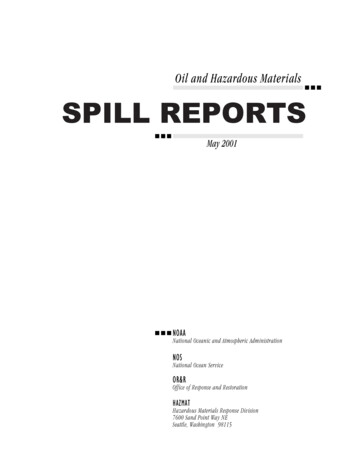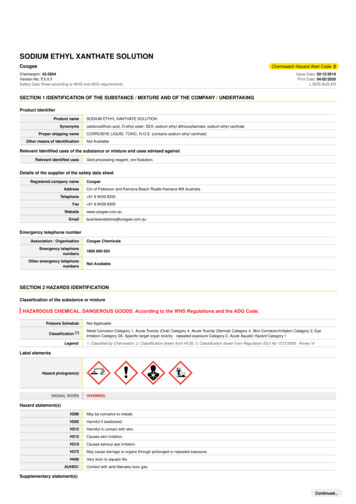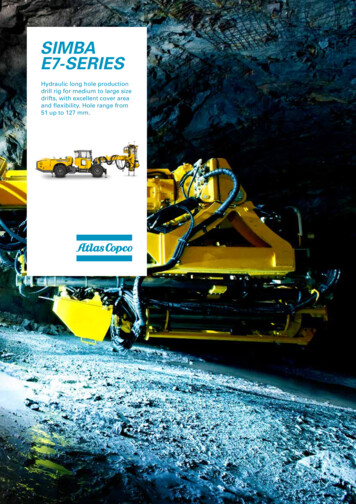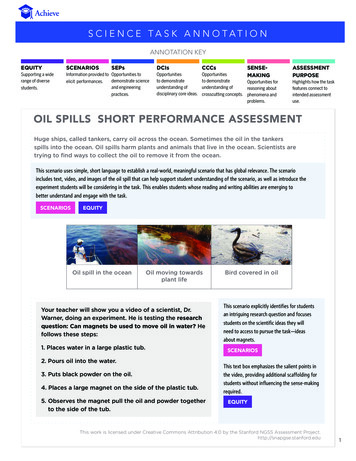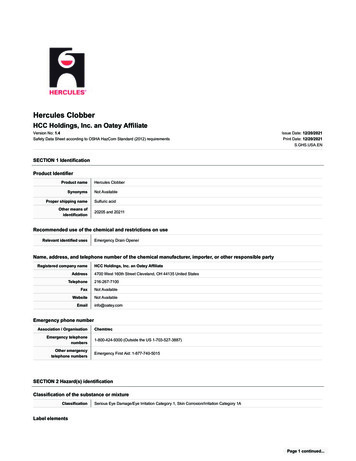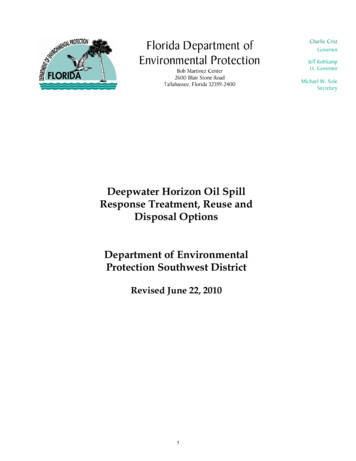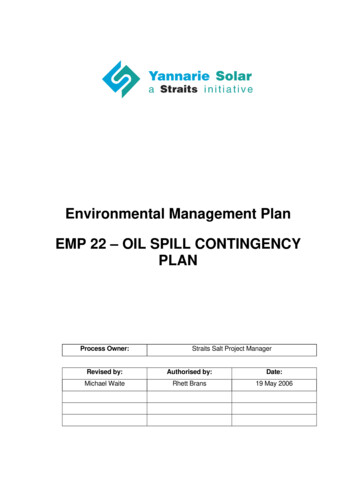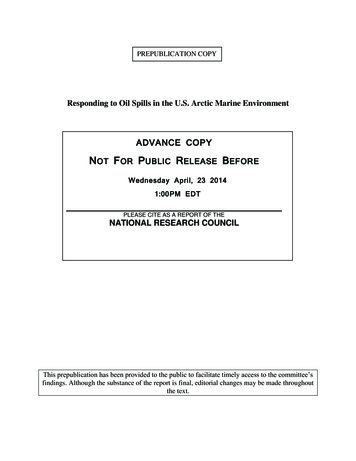
Transcription
PREPUBLICATION COPYResponding to Oil Spills in the U.S. Arctic Marine EnvironmentADVANCE COPYNOT FOR PUBLIC RELEASE BEFOREWednesday April, 23 20141:00PM EDTPLEASE CITE AS A REPORT OF THENATIONAL RESEARCH COUNCILThis prepublication has been provided to the public to facilitate timely access to the committee’sfindings. Although the substance of the report is final, editorial changes may be made throughoutthe text.
RESPONDING TOOil SpillsIN THEU.S. ARCTICMARINE ENVIRONMENT
RESPONDING TO OIL SPILLS IN THE U.S. ARCTIC MARINE ENVIRONMENTPREPUBLICATION DRAFTCommittee on Responding to Oil Spills in the U.S. Arctic Marine EnvironmentOcean Studies BoardDivision of Earth and Life StudiesPolar Research BoardDivision of Earth and Life StudiesMarine BoardTransportation Research BoardTHE NATIONAL ACADEMIES PRESSWashington, D.C.www.nap.eduPREPUBLICATION COPY
THE NATIONAL ACADEMIES PRESS500 Fifth Street, NWWashington, DC 20001NOTICE: The project that is the subject of this report was approved by the Governing Board ofthe National Research Council, whose members are drawn from the councils of the NationalAcademy of Sciences, the National Academy of Engineering, and the Institute of Medicine. Themembers of the committee responsible for the report were chosen for their special competencesand with regard for appropriate balance.Funding for this study was provided by the U.S. Arctic Research Commission, the AmericanPetroleum Institute under grant number 2011-105958, the U.S. Coast Guard under cooperativeagreement number DTMA1H11001, U.S. Department of the Interior, Bureau of Ocean EnergyManagement under purchase order number M11PX00116 and Bureau of Safety andEnvironmental Enforcement under purchase order number E12PX00061, the Marine MammalCommission under purchase order number DC-260-79EC085782, the National Oceanic andAtmospheric Administration under contract number WC133R-11-CQ-0048, the Oil SpillRecovery Institute under grant number 12-10-02, and the National Academy of Sciences. Anyopinions, findings, conclusions, or recommendations expressed in this publication are those ofthe authors and do not necessarily reflect the views of the organizations or agencies that providedsupport for the project.Library of Congress Cataloging-in-Publication DataorInternational Standard Book Number 0-309-0XXXX-XLibrary of Congress Catalog Card Number 97-XXXXXCover photograph provided by Richard Glenn, Arctic Slope Regional Corporation.Additional copies of this report are available for sale from the National Academies Press, 500Fifth Street, NW, Keck 360, Washington, DC 20001; (800) 624-6242 or (202) 334-3313;Internet, http://www.nap.edu/.Copyright 2014 by the National Academy of Sciences. All rights reserved.Printed in the United States of America
The National Academy of Sciences is a private, nonprofit, self-perpetuating society ofdistinguished scholars engaged in scientific and engineering research, dedicated to thefurtherance of science and technology and to their use for the general welfare. Upon theauthority of the charter granted to it by the Congress in 1863, the Academy has a mandate thatrequires it to advise the federal government on scientific and technical matters. Dr. Ralph J.Cicerone is president of the National Academy of Sciences.The National Academy of Engineering was established in 1964, under the charter of theNational Academy of Sciences, as a parallel organization of outstanding engineers. It isautonomous in its administration and in the selection of its members, sharing with the NationalAcademy of Sciences the responsibility for advising the federal government. The NationalAcademy of Engineering also sponsors engineering programs aimed at meeting national needs,encourages education and research, and recognizes the superior achievements of engineers. Dr.C. D. Mote, Jr., is president of the National Academy of Engineering.The Institute of Medicine was established in 1970 by the National Academy of Sciences tosecure the services of eminent members of appropriate professions in the examination of policymatters pertaining to the health of the public. The Institute acts under the responsibility given tothe National Academy of Sciences by its congressional charter to be an adviser to the federalgovernment and, upon its own initiative, to identify issues of medical care, research, andeducation. Dr. Harvey V. Fineberg is president of the Institute of Medicine.The National Research Council was organized by the National Academy of Sciences in 1916 toassociate the broad community of science and technology with the Academy’s purposes offurthering knowledge and advising the federal government. Functioning in accordance withgeneral policies determined by the Academy, the Council has become the principal operatingagency of both the National Academy of Sciences and the National Academy of Engineering inproviding services to the government, the public, and the scientific and engineeringcommunities. The Council is administered jointly by both Academies and the Institute ofMedicine. Dr. Ralph J. Cicerone and Dr. C. D. Mote, Jr., are chair and vice chair, respectively,of the National Research Council.www.national-academies.orgPREPUBLICATION COPY
COMMITTEE ON RESPONDING TO OIL SPILLS IN ARCTIC MARINE ENVIRONMENTSDr. Martha R. Grabowski (Chair), Le Moyne College, Syracuse, New York and RensselaerPolytechnic Institute, Troy, New YorkDr. Thomas Coolbaugh, ExxonMobil Research and Engineering, Fairfax, VirginiaMr. David F. Dickins, DF Dickins and Associates, LLC, La Jolla, CaliforniaMr. Richard Glenn, Arctic Slope Regional Corporation, Barrow, AlaskaDr. Kenneth Lee, Commonwealth Scientific and Industrial Research Organisation, AustraliaMr. William (Lee) Majors, Alaska Clean Seas, Prudhoe BayDr. Mark D. Myers, University of Alaska, FairbanksDr. Brenda L. Norcross, University of Alaska, FairbanksDr. Mark Reed, SINTEF, NorwayVADM Brian Salerno,1 BIMCO, Washington, D.C.Dr. Robert Suydam, North Slope Borough, Barrow, AlaskaDr. James M. Tiedje (NAS), Michigan State University, East LansingDr. Mary-Louise Timmermans, Yale University, New Haven, ConnecticutDr. Peter Wadhams, Cambridge University, United KingdomPolar Research Board LiaisonsMolly McCammon - Alaska Ocean Observing System, Anchorage, AlaskaCaryn Rea – ConocoPhillips, Anchorage, AlaskaNational Research Council StaffDeborah Glickson, Senior Program OfficerLauren Brown, Associate Program Officer, Polar Research BoardStacee Karras, Research AssociateHeather Chiarello, Senior Program Assistant (until April 2013)Payton Kulina, Program Assistant (from June 2013)1Resigned from the committee.vPREPUBLICATION COPY
PREFACEBalance. This is an important word in the Arctic, an area that serves as an integrator ofmany of the Earth's large-scale systems and processes, and also an area where choices made havesubstantial impact on the Arctic and its neighbors. Many competing forces co-exist and collide inthe Arctic: harsh environmental conditions, economic drivers, science and technologycapabilities, logistical and infrastructure challenges, ecosystem protection needs, food securityconcerns, and the needs of traditional cultures and societies. Balancing the needs andrequirements of these forces is part of the challenge and opportunity presented in the complex,large-scale system that is the Arctic.Within this context, the National Research Council was asked by eight sponsors whorepresent many of these drivers to consider the adequacy and sufficiency of resources,technology, research, manpower, funding and logistics to respond to an Arctic oil spill. Thecommittee sought to balance in its work traditional and scientific knowledge of the Arctic and ofoil spill response operations, engineering, technology, policies, procedures and equipment. Itconsidered the needs and concerns of the committee's sponsors; government, public, private, forand not-for-profit organizations; citizens and organizations with Arctic interests; and the needsand interests of Arctic inhabitants. The committee also considered lessons learned from eventsand case studies from oil spill response efforts around the world.The committee's work was enhanced by the participation and input provided by a numberof individuals, organizations, and groups, many of whom are listed elsewhere in this report. Thecommittee solicited input from workshop participants, speakers and experts across the spectrumof traditional knowledge, science, engineering, vessel and oil spill operations, and regulatory andgovernment affairs. The committee's work was also enhanced by the insight, experience, andcollegiality of its globally distributed members, as it followed the tenets of an earlier NationalResearch Council (1996) report, to "get the science right and get the right science; to get theparticipation right and get the right participation; and to develop an inclusive and thoughtfulanalytic-deliberative process." The result is a report that considers the adequacy of and needs foroil spill response in the U.S. Arctic, drawing on the wisdom and expertise of many in and of theArctic, and that considers significant challenges in an important ecosystem.It was my privilege to work with our committee; our project sponsors; our study director,Deb Glickson; Polar Research Board Associate Program Officer Lauren Brown; Ocean StudiesBoard Director Susan Roberts; Marine Board Directors Joedy Cambridge and Scott Brotemarkle;and the rest of the National Academies staff during the course of this study. Thank you all forsharing your wisdom and insight. May we meet again in future endeavors.---M. GrabowskiviiPREPUBLICATION COPY
ACKNOWLEDGMENTSThis report was greatly enhanced by the participants of meetings held as part of thisstudy. The committee would like to acknowledge those who gave presentations at committeemeetings: Bill Adams (RESTCo), Doug Baird (NOAA), Geoff Baker (Crowley), Mary Baker(NOAA), Lawson Brigham (UAF), Christy Bohl (BSEE), Gene Brooks (Maersk), Harry Brower,Jr. (North Slope Borough Department of Wildlife Management), Larry Dietrick (AlaskaDepartment of Environmental Conservation), Hajo Eicken (UAF), Michael Faust(ConocoPhillips), Jeffrey Ferguson (NOAA), Adrian Gall (ABR Inc.), Larry Hinzman (UAF),Charles Hopson, John Hopson, Jr. (Wainwright Public Works), Christopher Ives (RESTCo),Christopher Krenz (Oceana), Nettie La Belle-Hamer (UAF), Joe LoSciuto (ASRC EnergyServices), Joe Mello Leavitt, Amy Merten (NOAA), Vince Mitchell (Lamor), RADM ThomasOstebo (U.S. Coast Guard), Ed Owens (Owens Coastal Consultants Ltd), Ed Page (MarineExchange), Shirish Patil (UAF), Vladimir Romanovsky (UAF), Stan Senner (OceanConservancy), Gay Sheffield (UAF), Kirk Sherwood (BSEE), Brad Smith (NOAA), MarkSwanson (Prince William Sound RCAC), Fran Ulmer (U.S. Arctic Research Commission), Petervan Tuyn (World Wildlife Fund), Peter Velez (Peter Velez Engineering LLC), Glen Watabayashi(NOAA), Thomas Weingartner (UAF), and Peter Winsor (UAF).The committee would also like to thank Karissa Goessl and Patrick Curtin of LeMoyneCollege, who assisted at the committee’s third meeting in Fairbanks, Alaska.This report has been reviewed in draft form by individuals chosen for their diverseperspectives and technical expertise, in accordance with procedures approved by the NRC’sReport Review Committee. The purpose of this independent review is to provide candid andcritical comments that will assist the institution in making its published report as sound aspossible and to ensure that the report meets institutional standards for objectivity, evidence, andresponsiveness to the study charge. The review comments and draft manuscript remainconfidential to protect the integrity of the deliberative process. We wish to thank the followingindividuals for their participation in their review of this report:Per Johan Brandvik, SINTEF Marine Environmental TechnologyLawson Brigham, University of Alaska, FairbanksBill Eichbaum, World Wildlife FundJohn Farrington, Woods Hole Oceanographic InstituteJacqueline Grebmeier, University of MarylandMolly McCammon, Alaska Ocean Observing SystemHumphrey Melling, Fisheries and Oceans CanadaJoseph Mullin, Joseph Mullin ConsultingPartha Patra, Columbia UniversityStephen Potter, SL Ross Environmental Research LimitedPonisseril Somasundaran (NAE), Columbia UniversityWilford Weeks (NAE), University of Alaska, Fairbanks (emeritus)Although the reviewers listed above have provided many constructive comments andsuggestions, they were not asked to endorse the conclusions or recommendations nor did theysee the final draft of the report before its release. The review of this report was overseen byixPREPUBLICATION COPY
RADM Malcolm MacKinnon (NAE), MacKinnon-Searle Consortium LLC, appointed by theDivison on Earth and Life Studies, and Bonnie McCay (NAS), Rutgers University, appointed bythe Report Review Committee, who were responsible for making certain that an independentexamination of this report was carried out in accordance with institutional procedures and that allreview comments were carefully considered. Responsibility for the final content of this reportrests entirely with the authoring committee and the institution.
CONTENTSSummary11Introduction132Environmental Conditions and Natural Resources in the U.S. Arctic233Arctic Oil Spill Response Research614Operations, Logistics, and Coordination in an Arctic Oil Spill975Strategies for Response and Mitigation127References141AppendixesACommittee and Staff Biographies171BNational Research Council Board Rosters177CAcronyms Used in the Report181xi
SCENARIOS, BOXES, FIGURES, AND TABLESScenarios1234567Passenger cruise ship accidentA large tanker spillBulk ore carrier driven in bad weatherA tug and barge incidentBreak in pipeline from near-shore productionA well blowoutStructural failure of an oil storage tank98104105121128134135Boxes1-11-2Select oil spills and maritime accidents of interestStatement of task19202-1Examples of risks associated with oil spill response due to weather conditions274-1Lessons learned from the Kulluk120FiguresS-1S-2Location map of Alaska and the continental United StatesLocation map of Alaska and U.S. Arctic waters1-11-21-3Location map of Alaska and the continental United StatesLocation map of Alaska and U.S. Arctic watersOil and gas planning areas in the Chukchi and Beaufort Seas1415172-12-22-32-42-52-62-72-82-92-102-11Water masses and sea ice extent in Bering Strait and Chukchi and Beaufort SeasMonthly average temperatures at the Barrow Automated Surface Observing SystemCross-section of typical Beaufort Sea ice zonesSegment of a MODIS image of the Chukchi coastMODIS image showing ice clearing in the Chukchi SeaPlans for additional nautical charts in the ArcticVisualization of the eastern Chukchi Sea food webDistribution of select fish species in U.S. Arctic watersDistribution of select bird species in U.S. Arctic waters and along coastDistribution of whales in U.S. Arctic watersDistribution of walrus, sea lions, and polar bears in U.S. Arctic waters24262932333842454749503-13-2Oil spill risk matrixEnvironmental processes that affect oil in open water and ice62654-1Arctic sea routes97xiiiPREPUBLICATION COPY23
4-24-3Relationship between Incident Command System and Unified CommandArctic infrastructure1021135-1Example of a tiered response system127Tables3-13-23-33-4Chemical and physical changes to oilIllustration of the impacts of ice and snowBeaufort and Chukchi Seas VLOS volumesOverview of remote sensing systems for detection of oil in ice67687188
SUMMARYThe Arctic system serves as an integrator for the Earth’s physical, biological, oceanic, andatmospheric processes, with impacts beyond the Arctic itself. The risk of an oil spill in the Arcticpresents hazards for Arctic nations and their neighbors.The threat of a major Arctic oil spill and the potential impacts on the region’s marineecosystems are of concern for a broad range of U.S. and international interests, includingAlaskan natives and others who live in the region, citizens and organizations concerned about thehealth of the Arctic environment, agencies committed to protecting the environment andthreatened species, agencies that regulate extractive activities or transportation, and industriesthat plan to develop oil and gas, shipping routes, fisheries, or tourism.Rapid climate change is leading to retreat and thinning of Arctic sea ice, potentiallyincreasing the accessibility of U.S. Arctic marine waters for commercial activities. With thisprojected rise in activity come additional concerns about the risk of oil spills. Recent interest indeveloping the rich oil and gas resources in federal waters offshore of Alaska has led toplanning, environmental assessments, and preliminary drilling for oil and gas exploration. Inaddition, expanding maritime activity in the region includes the potential for greater seasonal useby tankers and bulk carriers, fishing fleets that follow the northward migration of fish stocks, andcruise ships interested in exploiting the public’s desire to interact with Arctic wilderness.The National Research Council was asked by the American Petroleum Institute, the U.S.Arctic Research Commission, the Bureau of Safety and Environmental Enforcement (BSEE), theBureau of Ocean Energy Management (BOEM), the U.S. Coast Guard (USCG), the MarineMammal Commission, the National Oceanic and Atmospheric Administration (NOAA), and theOil Spill Recovery Institute to assess the current state of science and engineering regarding oilspill response and environmental assessment of Arctic marine waters, with emphasis on potentialimpacts in U.S. waters in the Bering Strait and Chukchi and Beaufort Seas. The committee wastasked to review research activities and recommend strategies to advance research and addressinformation gaps, to identify opportunities and constraints for advancing oil spill research, todescribe promising new concepts and technologies, and to assess the types of baselineinformation needed to monitor the impacts of an oil spill and to develop plans for recovery andrestoration.THE ARCTIC ENVIRONMENTArctic oil spill response is challenging because of extreme weather and environmentalconditions; the lack of existing or sustained communications, logistical, and informationinfrastructure; significant geographic distances; and vulnerability of Arctic species, ecosystems,and cultures.A fundamental understanding of the dynamic Arctic region (Figures S.1 and S.2) isneeded to help guide oil spill response and recovery efforts. Information on physical processes—including ocean circulation, ice cover, marine weather, and coastal processes—is important toframe the environmental context for the Arctic ecosystem and can help responders predict whereoil will spread and how weathering might change its properties. Parameters such as air and water1PREPUBLICATION COPY
2Responding to Oil Spills in the U.S. Arctic Marine Environmenttemperature, wind velocity, and hours of daylight are important considerations in choosing aneffective and safe response strategy.Figure S.1 Location map of Alaska and the continental United States, and surrounding countries and water bodies.The red box shows the location of the inset map in Figure S.2. Bathymetry, geopolitical boundaries, capitals, andselect Alaskan cities are also shown.Knowledge of ice thickness, concentration, and extent is essential for anticipating thelikely behavior of oil in, under, and on ice and determining applicable response strategies, whilehigh-quality bathymetry, nautical charting, and shoreline mapping data are needed for marinetraffic management and oil spill response. From a biological perspective, understandingpopulation dynamics and interconnections within the Arctic food web will enable thedetermination of key species that are most important for monitoring in the instance of an oil spill.PREPUBLICATION COPY
Summary3Figure S.2 Location map of Alaska and U.S. Arctic waters, focused on the Bering Strait, Chukchi Sea, and BeaufortSea. Geopolitical boundaries, principal coastal communities, cities, and bathymetry are also shown. Map areacorresponds to the red box in Figure S.1.Baseline data are critical to assess changes over time. In the Arctic, historical data do notprovide reliable baselines to assess current environmental or ecosystem states, nor can they fullyanticipate potential impacts due to factors such as seasonal and interannual variations or climatechange. Instead, monitoring approaches will need to take advantage of benchmarks, or referencepoints over time, rather than static baselines. Critical types of benchmark data for oil spillresponse in the Arctic include: Spatial and temporal distributions and abundances for fishes, birds, and marinemammals; Subsistence and cultural use of living marine resources; Identification and monitoring of areas of biological significance; Rates of change for key species; Sensitivity of key Arctic species to hydrocarbons; High-resolution coastal topography and shelf bathymetry; and Measurements of ice cover, thickness, and distribution.PREPUBLICATION COPY
4Responding to Oil Spills in the U.S. Arctic Marine EnvironmentAdditional research and development needs include meteorological-ocean-ice forecastmodel systems at high temporal and spatial resolutions and better assimilation of traditionalknowledge of sea state and ice behavior into forecasting models. Releasing proprietarymonitoring data from exploration activities would increase knowledge of Arctic benchmarkconditions. When appropriate, Arctic communities could also release data that they holdregarding important sites for fishing, hunting, and cultural activities.In many instances, frequent and regular long-term monitoring will be needed todetermine trends. Because data are or will be collected by a number of local, state, and federalagencies, as well as industry and academia, a complete information system that integrates Arcticdata in support of oil spill preparedness, response, and restoration and rehabilitation is needed.Achieving this goal requires the development of international standards for Arctic datacollection, sharing, and integration. A long-term, community-based, multiuse Arctic observingsystem could provide critical data at a variety of scales.Recommendation: A real-time Arctic ocean-ice-meteorological forecasting system is neededto account for variations in sea ice coverage and thickness and should include patterns ofice movement, ice type, sea state, ocean stratification and circulation, storm surge, andimproved resolution in areas of potential risk. Such a system requires robust, sustainable,and effective acquisition of relevant observational data.Recommendation: High-resolution satellite and airborne imagery needs to be coupled withup-to-date high-resolution digital elevation models and updated regularly to capture thedynamic, rapidly changing U.S. Arctic coastline. Nearshore bathymetry and topographyshould be collected at a scale appropriate for accurate modeling of coastline vulnerabilityand storm surge sensitivity. Short- and long-term Arctic nautical charting and shorelinemapping that have been identified in NOAA and U.S. Geological Survey plans should beadequately resourced, so that mapping efforts can be initiated, continued, and completed intimescales relevant to anticipated changes. To be effective, Arctic mapping prioritiesshould continue to be developed in consultation with stakeholders and industry and shouldbe implemented systematically rather than through surveys of opportunity.OIL SPILL RESPONSE RESEARCHA comprehensive, collaborative, long-term Arctic oil spill research and development programthat integrates all knowledgeable sectors and focuses on oil behavior, response technologies,and controlled field releases is needed.Laboratory experiments, field research, and practical experience gained from respondingto past oil spills have built a strong body of knowledge on oil properties and oil spill responsetechniques. However, much of the work has been done for temperate regions, and there are areaswhere additional research is needed to make informed decisions about the most effectiveresponse strategies for different Arctic situations. In the presence of lower water temperatures orsea ice, the processes that control oil weathering—such as spreading, evaporation, photooxidation, emulsification, and natural dispersion—are slowed down or eliminated for extendedperiods of time. Due to encapsulation of oil by new ice growth, oil can also be separated from thePREPUBLICATION COPY
Summary5environment for months at a time. Understanding how oil behaves or changes in the Arcticenvironment can help define the most effective oil spill response actions.In addition to ongoing research on oil properties and weathering in high latitudes, there isa need to validate current and emerging oil spill response technologies on operational scalesunder realistic environmental conditions. Carefully planned and controlled field releases of oil inthe U.S. Arctic would improve the understanding of oil behavior in the Bering Strait andBeaufort and Chukchi Seas and allow for the evaluation of new response strategies specific tothe region. Scientific field releases that have been conducted elsewhere in the Arctic demonstratethat such studies can be carried out without measureable harm to the environment.Recommendation: A comprehensive, collaborative, long-term Arctic oil spill research anddevelopment program needs to be established. The program should focus on understandingoil spill behavior in the Arctic marine environment, including the relationship between oiland sea ice formation, transport, and fate. It should include assessment of oil spill responsetechnologies and logistics, improvements to forecasting models and associated data needs,and controlled field releases under realistic conditions for research purposes. Industry,academic, government, non-governmental, grassroots, and international efforts should beintegrated into the program, with a focus on peer review and transparency. An interagencypermit approval process that will enable researchers to plan and execute deliberate releasesin U.S. waters is also needed.Oil Spill CountermeasuresKey response countermeasures and tools for oil removal in Arctic conditions includebiodegradation (including oil treated with dispersants), in situ burning, chemical herders,mechanical containment and recovery, detection and tracking, and oil spill trajectory modeling.These are joined by the “no response” option of natural recovery, which is a viable alternative insome situations. No single technique will apply in all situations. The oil spill response toolboxrequires flexibility to evaluate and apply multiple response options, if necessary. Well-definedand well-tested decision processes are critical to expedite review and approval of countermeasureoptions in emergency situations.Biodegradation and DispersantsBiodegradation of petroleum hydrocarbons by naturally occurring microbial communitiesis a major process contributing to the eventual removal of oil that enters the marine environment.Recent studies suggest that indigenous bacteria in Arctic waters degrade oil faster thanpreviously thought and that biodegradation is not strongly inhibited by cold water temperatures.Current research is focused on better understanding of this environmentally important process.Chemical dispersants facilitate the dilution of oil in the water column and promotebiodegradation. There has been considerable debate over the effectiveness of chemicaldispersants at low seawater temperatures, but recent studies have shown that dispersants can beeffective on nonemulsified oil at freezing temperatures if viscosity does not increasesignificantly.Subsea injection of dispersant is a promising option for mitigation of oil spills from awellhead blowout and could disperse oil at higher rates and with higher efficiency than aerialPREPUBLICATION COPY
6Responding to Oil Spills in the U.S. Arctic Marine Environmentapplication. Subsea injection can also operate independent of darkness, extreme temperatures,strong winds, rough seas, or the presence of ice. However, more work needs to be done on theeffectiveness, systems design, and short- and long-term impacts of subsea dispersant delivery.Recommendation: Dispersant pre-approval in Alaska should be based on sound science,including research on fates and effects of chemically dispersed oil in the Arcticenvironment, experiments using oils that are representative of those in the Arctic, toxicitytests of chemically dispersed oil at realistic concentrations and exposures, and the use ofrepresentative microbial and lower-trophic benthic and pelagic Arctic species atappropriate temperatures and salinities.In Situ BurningIn situ burning is a viable spill response countermeasure in the Arctic. Ice can oftenprovide a natural barrier to maintain the necessary oil thicknesses for ignition, without the needfor booms. With relatively fresh oil that is wind-herded against an ice edge, or collects in meltpools in the spring, removal efficiencies in excess of 90% are achievable through in situ burning.However, in very open drift ice conditions, oil spills can rapidly spread too thinly to ignite. Toimprove the limits of in situ burning, further research is needed to evaluate improved ignitionmethods and to explore the use of aerially applied oil-herding chemicals at different spatialscales and with different oil types, including weathered states.Mechanical Containment and RecoveryMechanical containment and recovery removes oil from the marine environment, ratherthan adding chemicals or generating burn residue. However, when dealing with large offshorespills, the oil can quickly spread to a thin sheen, which makes it difficult to achieve a significantrate of recovery. Large quantities of containment boom and hundreds
oil spill response operations, engineering, technology, policies, procedures and equipment. It considered the needs and concerns of the committee's sponsors; government, public, private, for- and not-for-profit organizations; citizens and organizations with Arctic interests; and the needs and interests of Arctic inhabitants.
